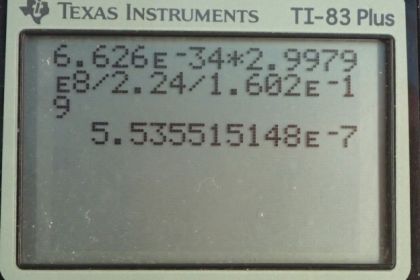Question
Find the longest-wavelength photon that can eject an electron from potassium, given that the binding energy is 2.24 eV. Is this visible EM radiation?
Final Answer
Yes, this is a visible wavelength. It is the color green.
Solution video
OpenStax College Physics for AP® Courses, Chapter 29, Problem 5 (Problems & Exercises)

vote with a rating of
votes with an average rating of
.
Calculator Screenshots
Video Transcript
This is College Physics Answers with Shaun Dychko. The electron binding energy in potassium is 2.24 electron volts and so we want to have a photon with that same energy will be the minimum frequency or, in other words, maximum wavelength that will have that energy. So we have this formula [29.5], which is that the kinetic energy of the electron is Planck's constant times frequency of the photon that was incident minus the binding energy. And if we set this kinetic energy to be 0 then we'll be getting the minimum frequency required, or, in other words, the maximum wavelength required. So the wave equation says that speed of light is the wavelength times frequency and then we can divide both sides by λ to solve for f and frequency is c over λ and so I substitute c over λ in place of f here. And I have also written the number 0 in place of kinetic energy. And then we'll add binding energy to both sides and then switch the sides around and we have hc over λ equals binding energy and then take the reciprocal of both sides and we have the λ in the numerator now and on the right side, we have 1 over binding energy and then multiply both sides by hc and you get a formula for the wavelength. So wavelength is Planck's constant times speed of light divided by binding energy and so that's Planck's constant there times the speed of light there divided by the binding energy— 2.24 electron volts— but we have to convert that into joules in order to match with the units that we chose for our Planck's constant there. So we'll multiply by 1.602 times 10 to the minus 19 joules for every electron volt. This works out to 554 nanometers; that is the maximum wavelength that will eject an electron from a potassium molecule, or atom, I should say. So and yes, this is a visible wavelength; it is the color green.
